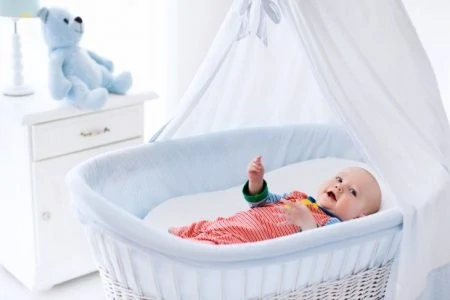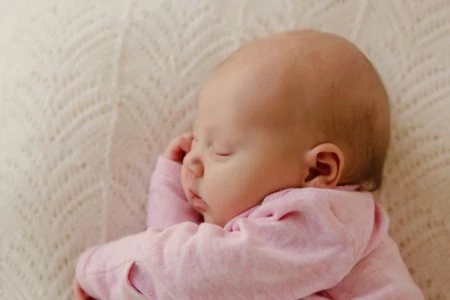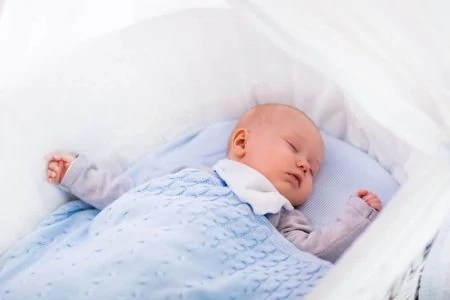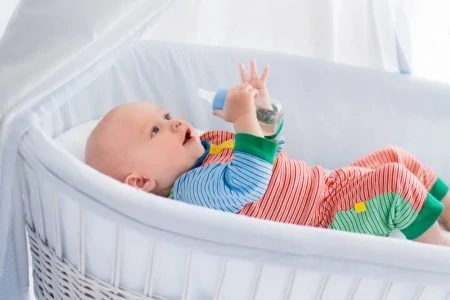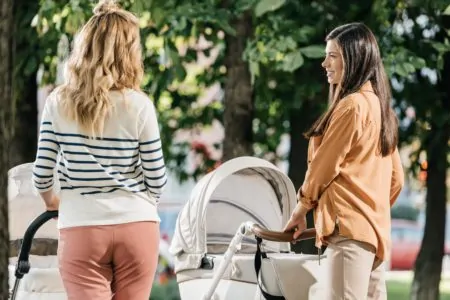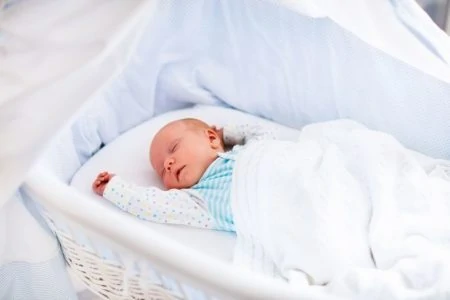You already know your baby’s sleep surface is the single biggest factor in protecting them from Sudden Infant Death Syndrome (SIDS). But between terrifying headlines and changing guidelines, figuring out the safest setup can feel overwhelming.
So, how do you ensure your little one sleeps soundly and safely?
We dug deep into the latest research and AAP guidelines to determine exactly what makes bassinets safe. In this guide, we’ll cut through the noise and give you the clear, non-negotiable rules for your baby’s sleep space so you can rest easy, too.
Key Takeaways
- Check the certification: Ensure your bassinet carries a JPMA seal or meets current CPSC standards to guarantee structural safety and stability.
- Keep it bare: The sleep space must be completely empty; no pillows, blankets, stuffed animals, or loose bedding.
- Firm is functional: Use only the firm, thin mattress pad provided by the manufacturer with a tight-fitting sheet.
- Watch the clock: Move your baby to a crib once they can roll over, push up on hands and knees, or reach the manufacturer’s weight limit.
The 3 Golden Rules of Bassinet Safety
Bassinet safety isn’t complicated, but it does require strict adherence to the rules. SIDS (Sudden Infant Death Syndrome) is often linked to unsafe sleeping practices, so setting up the environment correctly is your first line of defense.
Here are the three non-negotiable rules for a safe sleep space:
1. Stick to modern standards
Vintage aesthetics are cute, but antique bassinets are often dangerous. Older models likely don’t meet current safety requirements regarding slat width, lead paint, or structural integrity. Using a certified, modern product is the only way to ensure safe baby sleep.
If you are eyeing a hand-me-down, you need to be a detective. Check that the mattress isn’t too soft and that the sides aren’t puffy or padded. You can verify the full list of required safety features for bassinets and cribs here.
The safest route? Buy new from a trusted retailer. Always check for recalls before using any baby gear. You can view the official federal recall list here.
2. Invest in mesh
Mesh walls are a game-changer for safety because they maximize airflow.
Imagine if your baby scoots over and presses their face against the side of the bassinet. You want that surface to be breathable mesh, not thick, padded fabric that could obstruct breathing.
Beyond safety, mesh sides allow you to see your baby from your own bed without having to sit up every time you hear a grunt or wiggle.
3. Lock it down
We love the portability of bassinets, but mobility has its time and place. Unless your bassinet is specifically designed as a stroller-hybrid or carrier, never move it while the baby is inside.
If your model has wheels, check them every single night to ensure they are locked tight. This is doubly important if you have older siblings or pets running around who might accidentally bump the bassinet.
Handling Recalls Like a Pro
Safety standards aren’t static; they evolve as we learn more. For instance, regulations tightened significantly in 2013, and more recently, the Safe Sleep for Babies Act of 2021 banned inclined sleepers entirely.
These updates exist to reduce infant injuries and deaths (1).
If a manufacturer or the CPSC issues a recall, it usually means an investigation found a flaw. If you own a recalled bassinet, stop using it immediately. Do not try to “fix” it yourself unless the manufacturer sends a specific repair kit.
Usually, you can return recalled products for a refund or voucher.
Safety Tip
Why “Bare is Best”
We know those nursery photos on Pinterest look cozy with pillows and quilts, but they are not safe. Any extra objects in the crib or bassinet pose a suffocation and entrapment risk. This includes toys, pillows, loose blankets, and positioners.
Keeping the sleep space empty drastically reduces SIDS risks. Data indicates that a significant percentage of sleep-related infant deaths involve unsafe bedding (2).
If you are worried about warmth, skip the loose blanket and use a sleep sack or wearable blanket. Swaddling is also great for newborns to prevent the startle reflex, but remember to stop swaddling the moment your baby shows signs of rolling over.
The Rules on Sheets
Fitted sheets are essential for hygiene and easy cleaning, but the fit must be exact.
Loose fabric is a hazard. Only use sheets designed specifically for your bassinet’s model and dimensions. Even a sheet that is slightly too big can bundle up and obstruct your baby’s breathing.
We recommend buying 2 or 3 extra fitted sheets made by the manufacturer. This ensures you have a safe backup during 3 a.m. diaper leaks without resorting to an ill-fitting makeshift solution.
Why the Mattress Must Be Firm
If you press on the mattress and it feels rock hard, that is actually good news.
Parents often worry their baby isn’t comfortable, leading them to add soft toppers or plush pads. This is dangerous. Soft surfaces can conform to the shape of the baby’s face if they roll over, increasing the risk of suffocation.
Newborns do not need soft clouds to sleep; they need safety. A firm, flat surface is the only safe place for a baby to sleep (3).
The Ban on Bumper Pads
This is a critical update: Bumper pads are now widely recognized as unsafe. In fact, the Safe Sleep for Babies Act prohibits the manufacture and sale of padded crib bumpers in the U.S. (4).
Bassinets generally don’t have slats, so there is absolutely no need for bumpers anyway. The mesh or fabric walls are sufficient.
Ideally, your baby’s sleep space should be free of any add-ons. As your child transitions to a toddler bed years down the road, you might look at rails, but for infants, less is always more.
When to Graduate to a Crib
Bassinets are a short-term solution, typically intended for the first 4 to 6 months. However, the transition isn’t just about age; it is about milestones.
You must stop using a bassinet if:
- Your baby rolls over: Once they can roll, the shallow depth of a bassinet becomes a fall hazard.
- Your baby pushes up: If they can push up on hands and knees, they can potentially vault over the side.
- They hit the weight limit: Check your manual; many bassinets have a limit of 15 to 20 lbs.
Once your baby hits any of these milestones, move them to a crib immediately (5).
